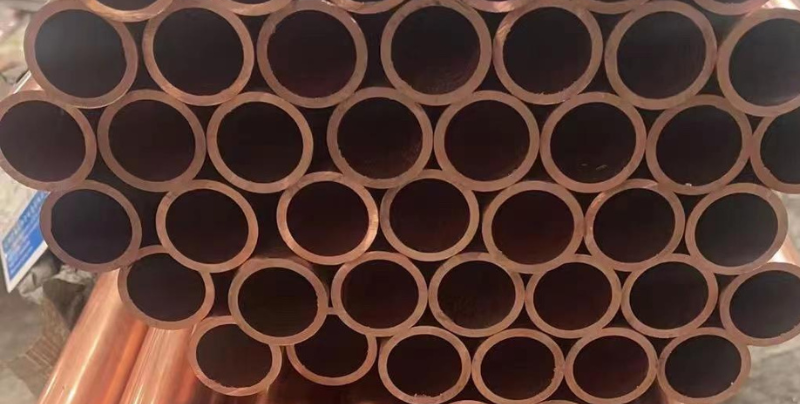What is copper tube?
Definition and Basic Structure of Copper Tubing
Copper tubing is a type of pipe used for transporting liquids and gases, primarily made from pure copper or copper alloys. Due to its excellent thermal and electrical conductivity, copper tubing has been widely used in various fields. Typically, copper tubing consists of an inner tube and an outer tube, where the inner tube is used to transport the medium and the outer tube provides protection. Copper tubing has a long history of use and continues to play an important role in modern industrial and residential applications.
Properties and Classification of Copper Tubing
Properties of Copper Tubing:
Thermal Conductivity: Copper tubing has extremely high thermal conductivity, making it indispensable in air conditioning and refrigeration equipment. Its efficient heat transfer capability makes it ideal for applications requiring rapid heat dissipation or transfer.
Electrical Conductivity: With excellent electrical conductivity, copper tubing is widely used in electrical equipment and wire manufacturing. In the electronics industry, copper tubing is often used to manufacture high-frequency cables and RF cables.
Corrosion Resistance: Copper tubing has good resistance to many chemical substances, allowing it to be used in both acidic and alkaline environments for extended periods. This property makes it widely used in the chemical industry.
Malleability: Copper tubing has good malleability, making it easy to process into various shapes and sizes to meet different engineering needs. This makes copper tubing widely adopted in construction and decorative projects.
Classification of Copper Tubing:
By Application:
Water Pipes: Used in building and residential water supply systems, favored for its corrosion resistance and durability.
Gas Pipes: Used for transporting natural gas and liquefied petroleum gas, with good sealing and safety features.
Air Conditioning Pipes: Used in refrigeration and air conditioning systems, enhancing system efficiency with its excellent thermal conductivity.
By Manufacturing Process:
Seamless Copper Tubing: Made from a single piece of copper through extrusion or drawing processes, with no seams, high strength, and widely used in high-pressure environments.
Welded Copper Tubing: Made by welding copper plates or strips, suitable for low-pressure environments, and relatively low in manufacturing cost.
Production Process of Copper Tubing
Material Selection: High-quality copper or copper alloys are the base materials for producing copper tubing, ensuring its thermal conductivity, electrical conductivity, and durability. Common copper alloys include brass and bronze, selected based on specific applications.
Cold Drawing Process: Cold drawing is the process of forming copper tubing by stretching it at room temperature. Through multiple drawing steps, the diameter and wall thickness of the copper tubing gradually decrease, and its strength and surface finish improve significantly. This process is typically used for producing small-diameter copper tubing with high precision requirements.
Hot Extrusion Process: Hot extrusion is the process of forming copper material at high temperatures. Copper material has better plasticity at high temperatures and can be extruded into complex cross-sectional shapes. This process improves the mechanical properties and consistency of copper tubing, making it suitable for manufacturing large-diameter and thick-walled copper tubing.
Welding Process: The welding process includes gas welding, electric welding, etc., used to connect copper plates or strips to form welded copper tubing. The welding process requires high standards to ensure the strength and sealing of the welded joints. Welded copper tubing is widely used in low-pressure environments and is relatively low in cost.
Market Prospects and Development Trends of Copper Tubing
Copper tubing is widely used in construction, refrigeration, electronics, medical, and other fields, with steadily growing market demand. With the accelerated urbanization process and continuous infrastructure development, the demand for copper tubing in construction and municipal engineering continues to increase. Additionally, the popularity of household appliances and industrial equipment has also driven the growth of the copper tubing market.
With technological progress, new copper tubing materials and manufacturing processes are constantly emerging. For example, the development and application of nano copper tubing and composite copper tubing further enhance the performance and application range of copper tubing. These new technologies not only improve the strength and durability of copper tubing but also reduce production costs and resource consumption.
Due to its excellent properties and wide applications, the future market prospects for copper tubing are promising. Especially in the context of increasing demands for environmental protection and energy efficiency, copper tubing will play an important role in more fields. As people's demand for efficient, energy-saving, and environmentally friendly materials increases, the application of copper tubing in new energy, green buildings, and smart manufacturing will further expand.
In conclusion, copper tubing, with its excellent performance and wide applications, has become an indispensable material in modern industry and daily life. With continuous technological advancement and growing market demand, the future development of copper tubing is full of potential.
